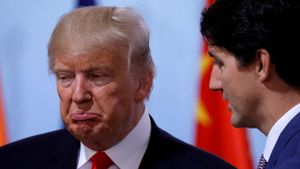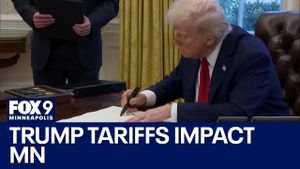NEW ORLEANS (AP) — The clergy sex abuse scandal has cast a long shadow over the Archdiocese of New Orleans, prompting leaders to turn to the unlikeliest of allies: the local NFL team, the New Orleans Saints. Internal emails obtained by the Associated Press reveal the depth of this alliance and the extent of the Saints' involvement during one of the Catholic Church's darkest chapters.
Once the archdiocese prepared to release its controversial list of credibly accused priests, church officials reached out to Saints executives for guidance as they braced for the ensuing fallout. At the forefront of this crisis communications strategy was Saints president Dennis Lauscha and senior vice president Greg Bensel, with the latter leveraging his extensive experience to navigate the turbulent media environment.
The crisis began to escalate after the archdiocese was hit by shocking media coverage surrounding the actions of George Brignac, who had previously served as a deacon, even after facing accusations of sexual abuse. This prompted Bensel to contact the Saints’ owner, Gayle Benson — herself a devout Catholic — to offer the church assistance.
Over the ensuing months, the email exchanges between Saints officials and church leaders will show how intertwined their efforts became as they sought to mitigate any potential damage to the church’s reputation and maintain public trust. According to Bensel, after witnessing the fallout from the Brignac case, it was clear to him how dire the situation had become. “The issues the Archbishop has to deal with never involve him,” Bensel wrote to Benson, framing the church's troubles as concerning one man.
The emails reflect extensive planning: Bensel assisted Archbishop Gregory Aymond prepare for media interviews, offering talking points and even crafting questions for the archbishop to address when facing reporters after the release of the clergy-abuser list.
Perhaps the most troubling discussion arose just before the public disclosure of this list. Bensel revealed to Lauscha about having had communication with then-New Orleans District Attorney Leon Cannizzaro, indicating it allowed the church to 'take certain people off' the list of accused clergy members. This statement raised eyebrows. Cannizzaro later denied any knowledge of the alleged conversation about list modifications, emphasizing his department had no influence over who was considered credibly accused.
The dynamics of the partnership highlighted the Saints' deep historic ties with the church. Since taking ownership of the Saints and the New Orleans Pelicans after the death of her husband Tom Benson, Gayle Benson has donated over $80 million to the archdiocese and other Catholic causes. Her faith motivates her connections, with Archbishop Aymond often regarded almost as family.
The collaboration inspired mixed feelings. Some questioned the ethics of the Saints' involvement, considering their past pledges of minimal contact. Lawmakers like state Rep. Mandie Landry have expressed outrage, questioning why the team would engage so deeply with protecting the interests of those accused of severe wrongdoing. “It doesn’t make any sense to me why the Saints would go to these lengths to protect grown men who raped children,” she lamented.
For survivors of abuse, the revelations stung acutely. Kevin Bourgeois, who had been abused by one of the clergy members listed, described feeling betrayed by the organization he had supported. He noted, “It forces me to question what other secrets are being withheld. I’m angry, hurt, and re-traumatized again.”
Despite the backlash, the Saints maintained their narrative. The team reiterated their involvement was purely for communication assistance, reflecting upon the seriousness of the situation at hand rather than any attempts to obfuscate the truth or modify the list of the clergy members.
With investigations now underway, the impact of this scandal extends far beyond the ecclesiastical structure. Federal and state probes are reviewing how allegations of clergy abuse were handled, with incalculable monetary consequences potentially leading the archdiocese toward bankruptcy.
Though the Saints claim they were simply aiding the archdiocese to manage adverse media coverage, the extent of their engagement raised questions of intertwined institutional loyalties and whether the team's involvement was more about protecting the church than serving justice for abuse survivors.
Internal emails paint this engagement as not only coordinated but strategic, pushing for positive narratives even as many known abusers remained off the list. And the question remains: how deeply did the Saints insert themselves, and what kind of legacy does this connection leave for both the team and the church?
The fallout from the release of this email chain creates broader discourse around the relationship between influential local entities and public accountability. Saints' involvement appears to blur the lines between support and cover-up, and as investigations continue, New Orleans’ residents and victims alike are left grappling with the consequences of this unholy alliance.



